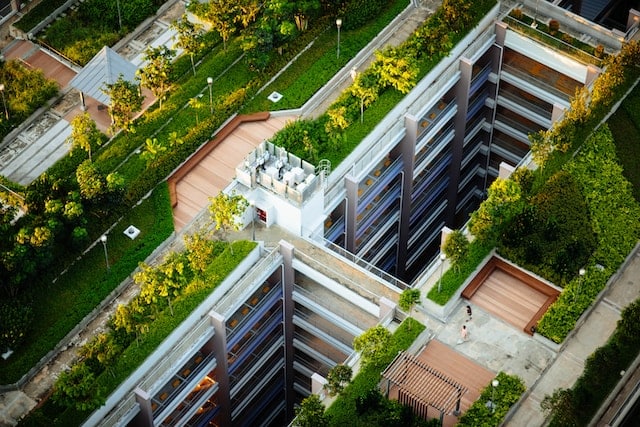Green cities: innovative urban planning for a sustainable future

As the world grapples with the challenges of climate change, urbanization, and an ever-growing population, the focus is shifting towards creating sustainable cities that are equipped to handle these challenges head-on. Urban areas are at the heart of this transformation, with the potential to drive a significant change towards a healthier and more sustainable future. A green city is not just an aspiration; it is a necessity, a blueprint for ensuring long-term environmental, social, and economic health.
Urban planning for the future involves a tapestry of complex elements – from energy systems and infrastructure to public health and social equity. It’s about integrating sustainability into every facet of city life, paving the way for urban areas to thrive in harmony with the environment. As you, the public, become more aware of the need for environmental stewardship and quality of life, urban development evolves to meet these demands through smart planning and innovative solutions.
Lire également : Combining diet pills and a balanced diet: An effective approach to weight loss ?
In this article, we’ll explore the facets of green cities, how urban areas can adapt to ensure a sustainable future, and the role that technology, society, and public policy play in this grand transformation. Whether you are a city dweller, an urban planner, or simply someone who cares about the future of our planet, this exploration of urban sustainability will shed light on the path to a greener, smarter, and more resilient world.
Foundations of sustainable urban development
To understand the impetus behind sustainable urban development, it’s essential to recognize the scope of urban challenges. Cities consume over two-thirds of the world’s energy and account for more than 70% of global carbon emissions. The concentration of people in urban areas often leads to environmental degradation, strained resources, and deteriorating public health. Sustainable urban development is designed to counteract these pressures by fostering cities that meet present needs without compromising the ability of future generations to meet their own.
A lire également : Hula Hoop: much more than just child's play!
At the core of the sustainability ethos are three pillars: environmental, economic, and social. Green cities aim to protect ecosystems and minimize environmental footprints while fostering economic growth and social wellbeing. Sustainable planning includes integrating renewable energy sources, enhancing green spaces, improving public transit, and creating inclusive communities. It’s about building a robust system that can withstand the long-term challenges posed by climate change and urbanization.
One of the first steps in this direction is to rethink urban infrastructure. Green infrastructure, like parks, green roofs, and water management systems, becomes an integral part of urban landscapes. These features not only improve public health by purifying air and providing recreational spaces but also help cities manage climate impacts such as heatwaves and flooding.
Embracing smart sustainable cities
The concept of a smart city takes the vision of sustainable urban areas further by incorporating technology into the management and operation of cities. A smart sustainable city uses digital technology, information, and innovation to improve the quality of life, efficiency of urban operation, and competitiveness, while ensuring that it meets the needs of present and future generations with respect to economic, social, and environmental aspects.
Smart sustainable cities leverage data and technology to optimize everything from traffic flow and energy use to public services and waste management. The urban planning process becomes more data-driven, enabling city planners to simulate and predict outcomes of various scenarios before implementing changes. This approach helps in making informed decisions that align with sustainability goals.
The integration of systems like the Internet of Things (IoT) in urban infrastructure allows for smarter resource management. Sensors can monitor energy usage, air quality, and water levels in real-time, enabling a more responsive and efficient city that conserves resources and reduces carbon emissions.
Green spaces and public health
An often-underappreciated aspect of green cities is the relationship between green spaces and public health. Parks, gardens, and tree-lined streets don’t just beautify the urban landscape; they are pivotal to the physical and mental well-being of citizens. Access to green spaces has been linked to reduced stress levels, increased physical activity, and better overall health outcomes.
The planning and development of urban green spaces are strategic, often involving the conversion of unused or underutilized areas into vibrant public parks or community gardens. These green pockets serve as the lungs of the city, improving air quality and providing a haven for biodiversity. They also play a crucial role in urban climate adaptation, mitigating the heat island effect prevalent in densely constructed areas.
In addition to health benefits, green spaces can also foster a strong sense of community. They are places for social interaction, cultural events, and physical activities that bring diverse groups of people together, strengthening the social fabric of the city.
Towards energy and climate resilience
The transition to sustainable cities is inextricably linked to energy and climate resilience. The future of urban development hinges on reducing dependence on fossil fuels and embracing renewable energy sources like solar, wind, and biomass. This shift not only curtails greenhouse gas emissions but also fortifies cities against energy supply disruptions.
A holistic approach to urban energy planning involves optimizing building design for energy efficiency, expanding public transportation options to reduce reliance on personal vehicles, and investing in smart grid technologies that can distribute energy more effectively. These strategies contribute to the creation of a resilient energy system that supports the city’s sustainability goals and prepares it for the impacts of climate change.
The challenges posed by climate change also demand adaptive measures. Cities are fortifying infrastructure against extreme weather events, rising sea levels, and other climate-related threats. Urban areas are becoming testbeds for innovative approaches to climate resilience, from permeable pavements that absorb rainwater to coastal defenses that blend with natural landscapes.
Planning for the long term
The transformation into green cities requires a vision that spans decades. Long-term planning is essential to ensure that the actions taken today align with the future we aspire to create. This necessitates a collaborative effort that includes governments, businesses, academia, and civil society, each playing a role in shaping the sustainable urban landscapes of tomorrow.
To support these efforts, platforms like Google Scholar provide access to a wealth of academic research on sustainable development, helping planners and policymakers stay informed about the latest breakthroughs and best practices. By incorporating evidence-based strategies, cities can evolve in ways that are both innovative and grounded in solid research.
Ultimately, the success of green cities hinges on the commitment to continuous improvement and adaptation. It’s a dynamic process, one that evolves with emerging technologies, changing social priorities, and the ever-present challenges of the global environment. The future of urban sustainability lies in the ability to anticipate change, adapt to new realities, and forge a path that leads to a greener, more prosperous world for all.
Conclusion
In the quest for a sustainable future, urban areas stand at the forefront of change. The transformation into green, smart, and resilient cities is not just a possibility—it’s an imperative. By embracing innovative urban planning strategies and technologies, cities can pave the way towards a future that is environmentally sound, economically robust, and socially inclusive.
From integrating green infrastructure and renewable energy systems to fostering public health and long-term resilience, the roadmap for sustainable cities is clear. It requires vision, collaboration, and unwavering commitment to the principles of sustainability. As we collectively face the challenges of climate change and urbanization, the cities that prioritize green and smart development today will lead the world into a brighter, more sustainable tomorrow.
